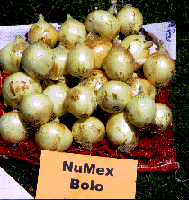NuMex Bolo

NuMex Bolo is a yellow, intermediate, open pollinated variety adapted for spring seeding or transplanting in southern New Mexico. NuMex Bolo was developed by professor Joe Corgan of the Department of Agronomy and Horticulture.
In 1979, nine onion varieties and one Germplasm were intercrossed to develop a broad gene pool from which to select open pollinated onion varieties. Included were USDA Germplasm similar to the Spartan Hybrids (provided by Grant Vest), Tucker Yellow Sweet Spanish (YSS), Utah YSS, El Capitan (Hybrid YSS type), Ring King (Hybrid YSS type), Inca (Hybrid YSS type), Peckham YSS, Ben Shemen (an intermediate variety), Colorado #6 (YSS type), and Texas Grano 502 PRR (a short day variety). Seeds were collected from the above parents separately. In 1981, Henry's Special (short day hybrid) was intercrossed with plants from the above intercross from the Tucker YSS, El Capitan, and Peckham YSS parents. Also in 1981 Texspan (a Ben Shemen type) was crossed with Temprana (a short day white).
Four populations were developed, two selected from the Peckham YSS seed from the 1979 intercross, one from the Henry's Special seed from the 1981 intercross, and one from the Texspan x Temprana cross, from Texspan as the maternal parent. Mass selection within the populations for either three or four generations produced lines that were uniform and similar to each other in maturity and bulb characteristics. In 1989, selected bulbs from each line were planted in a single pollination cage for intercrossing, to produce the 9168 line which was evaluated in 1992 and 1994 for possible release. A seed increase from selected bulbs from the 9168 line was designated 9327 and was evaluated in 1994. Breeder's seed of NuMex Bolo was produced by seed to seed increase from the 9327 selection.
Maternal parents thought to be in N cytoplasm included in NuMex Bolo are Peckham YSS and Texspan. Henry's Special is reported to be a hybrid and therefore contributed S cytoplasm. Several parents contributed genes for male sterility (ms). NuMex Bolo should be an excellent source from which to select both A and B lines for hybrid varieties. No attempt was made to estimate the relative percentages of N and S cytoplasm, nor the frequency of ms genes.
Selection criteria included: Intermediate maturity of July 5 to 10 at Las Cruces NM, resistance to pink root disease (Pyrenochaeta terrestris), globe shape, bulb firmness and single centers. Bulbs were selected at maturity in fields severely infested with P. terrestris.
NuMex Bolo matures about July 5 from direct seeding, or about June 25 from transplanting in southern New Mexico. Maturity has consistently been the same as or only a few days later than Cimarron. NuMex Bolo is highly resistant to pink root disease, and has consistently produced high yields on pink root infested soils. Bulbs are predominantly medium depth globe shape, and are firm to hard. Scale color is medium yellow, similar to Sweet Spanish varieties, and darker than the grano types like NuMex BR 1 or NuMex Sunlite. Necks are small.
NuMex Bolo is suggested for testing from transplanting or direct seeding wherever intermediate onion varieties are grown. It is highly promising for production in southern New Mexico.